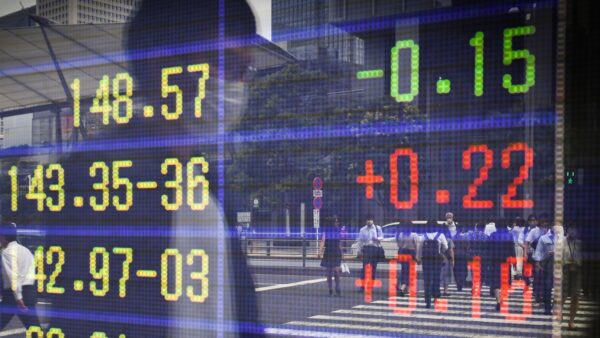By Rita Nazareth
Stocks whipsawed as traders geared for another super-sized US rate hike amid mounting fears on whether the Federal Reserve could overtighten and raise the odds of a hard landing.

The equity market had a tough time finding direction, with Treasury 10-year yields hovering near 3.5%. The two-year rate, which is more sensitive to imminent Fed moves, hit the highest since 2007. The dollar fluctuated.
Traders are pricing in the Fed will hike by 75 basis points Wednesday, signal rates are heading above 4% and will then pause. The long hold strategy is rooted in the idea the central bank would avoid the disastrous stop-go policy of the 1970s that allowed inflation to get out of hand. While a case can be made for going bigger, a shock full-point hike could add to recession jitters.
“This Fed meeting is going to have global markets at the edge of their seats,” wrote Matt Miskin, co-chief investment strategist at John Hancock Investment Management. “Speculating on the market’s reaction to short-term Fed moves is nearly impossible to predict on several levels. For example, markets may deem it dovish for them to do just a 0.75% rate hike as the whisper is that it could be 1.00%.”
Ed Yardeni, president of his namesake research firm who nailed the market bottom in 1982 and 2009, sees the Fed boosting rates by a full point this month, with both Chair Jerome Powell and the central bank’s economic projections looking hawkish. He noted that could cause the S&P 500 to retest its June 16 low of 3,666.77 — roughly 5% below current levels.
To Sam Stovall, chief investment strategist at CFRA Research, a 100-basis-point hike would “unnerve Wall Street as it would imply that the FOMC is overreacting to the data rather than sticking to its game plan.” Following the previous seven rate increases of that magnitude, the US equity benchmark fell four times each over one-, three-, and six-month periods, he added.
While a policy surprise could certainly move markets, the Fed’s revised forecasts for where the policy rate will ultimately come to rest and how long it’s likely to stay at that level will be equally important. Swap contracts that forecast rates over the next two years now peak at 4.5% in March 2023 — a full point higher than was expected after the last meeting in July.
“Due to current negative indicators including high inflation and the Fed’s upcoming rate announcement, global economic growth concerns and earnings expectations, we expect to see a continued negative pattern in the near-term,” said Mark Hackett, chief of investment research at Nationwide. “It will not take much good news to light a fire under the market, but we don’t expect that good news to come in the next few weeks.”
In a sign of how severe the equity beatdown has been, the S&P 500 has been trading below a key technical level for the longest stretch since the global financial crisis. Its long-term trend has turned “sharply lower recently,” and the index has closed below its 200-day moving average for 110 trading sessions, the longest streak since the bear markets of 2008-2009 and 2000-2002, according to Bespoke Investment Group.
Bond issuers also seem cautious about the market now. Four potential high-grade borrowers looked at selling bonds Monday, but ultimately opted to stand down amid a volatile start to trading. Supply is now running well below forecasts for September, with rapidly rising yields derailing some issuers’ plans.
In a time-tested harbinger of an economic downturn, short-term US rates have exceeded yields on longer maturities for months. The MLIV Pulse survey, which drew 737 responses, showed that the bulk of contributors expect a deeper inversion. Some see it reaching levels last seen in the early 1980s, when Paul Volcker ratcheted up borrowing costs to break the back of hyperinflation.
The majority of the MLIV survey’s contributors say it’s best to bet on dollar gains, and 44% prefer to sell stocks.
Key events this week:
- US housing starts, Tuesday
- EIA crude oil inventory report, Wednesday
- US existing home sales, Wednesday
- Federal Reserve decision, followed by a news conference with Chair Jerome Powell, Wednesday
- Bank of Japan monetary policy decision, Thursday
- The Bank of England interest rate decision, Thursday
- US Conference Board leading index, initial jobless claims, Thursday
Some of the main moves in markets:
Stocks
- The S&P 500 was little changed as of 2:18 p.m. New York time
- The Nasdaq 100 was little changed
- The Dow Jones Industrial Average was little changed
- The MSCI World index fell 0.2%
Currencies
- The Bloomberg Dollar Spot Index was little changed
- The euro was little changed at $1.0009
- The British pound was little changed at $1.1415
- The Japanese yen fell 0.3% to 143.36 per dollar
Bonds
- The yield on 10-year Treasuries advanced three basis points to 3.48%
- Germany’s 10-year yield advanced five basis points to 1.80%
Commodities
- West Texas Intermediate crude rose 0.7% to $85.69 a barrel
- Gold futures fell 0.2% to $1,679.50 an ounce
More stories like this are available on bloomberg.com.




